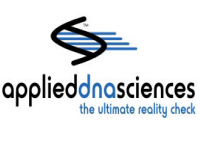Applied DNA Sciences Continues DLA Contract

By: Mary Dunham
Applied DNA Sciences has been awarded a one-year firm-fixed price Indefinite Delivery Purchase Order contract for FSC 5962 microcircuits by the US Defense Logistics Agency. According to the announcement made by the company on November 15, 2016, the contract ensures support and continuation for their current DNA program, which has been in place since December 2014 at DLA's Land and Maritime facility in Columbus, Ohio. The new contract calls for Applied DNA Sciences to provide supplies and services for DNA marking; create their SigNature® DNA marks; QC authentication testing; ink and supplies; and training. The new contract will run for one year and has an additional one-year option period.
The system uses plant DNA to forensically mark items so that the item's provenance can be traced. The DNA is suspended in a tiny dot of epoxy ink that is applied pneumatically and heat-cured, and has been proven to withstand demanding conditions. Once applied, the mark is scanned by the end-user. According to Applied DNA Sciences, the DNA provides a unique signature that counterfeiters cannot duplicate and there are additional levels of security and complexity built into the system to prevent reverse-engineering.
i
The markers are custom manufactured to identify a class of individual products or items. Each individual marker is recorded and stored in a secure database. A single SigNature® DNA marker can be authenticated approximately 10 times in its lifetime so can be identified for years.
Since being established, the DLA's Land and Maritime Product Test Center's DNA-marking lab has marked more than 120,000 microcircuits that support numerous military applications. More than 700,000 microcircuits have been DNA marked and are in circulation.
ii In addition to microchips, this marking technique is being used on electrical and electronic components, bearings, vehicle components, engine parts, pipes, tubing, hoses and fittings and hardware and abrasives. Applied DNA Sciences is looking to introduce the technique to a wider range of commodities so that traceability can be established and prevent counterfeit products from entering supply chains.
Applied DNA Sciences completed two additional contracts by the end of August 2016: one for the Missile Defense Agency Small Business Innovative Research (SBIR) and one for the office of the Secretary of Defense – Rapid Innovation Fund (RIF).
The SBIR allowed the company to continue their focus on microcircuits and scale-up of the business model to support volume at the point of manufacture.
The RIF expanded on the current DNA program for FSC 5962 microcircuits to establish a single authentication platform for: Electrical and Electronic Equipment Components; Bearings; Vehicular Equipment Components; Engine Accessories; Pipe, Tubing, Hose and Fittings; and Hardware and Abrasives.
iii The RIF provides increased capacity and enables expanded marking and authentication options across a wider range of commodities. RIF also offers varied levels of customization for manufactures to incorporate DNA at differing points in their processes, effectively providing more capability over a wider number of products.
iv
Applied DNA Sciences recently entered into an agreement with ActionPak, Inc. (a provider of packaging services for both commercial and military customers) to provide tamper-evident labels combining SigNature®DNA marks and Beacon, the company's "locked optical marker" for real-time inspections. Beacon provides covert screening that can be applied to packaging, labels and valuable assets through inks and varnishes, using a patent-pending "unique encrypted mechanism"
v. ActionPak had previously worked with Applied DNA Sciences in a pilot project for forensic authentication and tracking solutions under the Department of Defense's RIF program. Initially, ActionPark will be using the system for their military suppliers but are looking to expand the technology to their entire customer base in the future.
James Hayward, Applied DNA President and CEO, stated:
"Together, these contracts have strengthened our core capabilities to offer supply-chain solutions across an expanded range of crucial commodities. These parts and assemblies are used in defense, industrial and consumer markets."
vi
i "The Pentagon Uses Plant DNA to Catch Counterfeit Parts"; Kyle Mizokami; November 21, 2016
ii "DNA Marking Technology Improves Quality Through Fraud Prevention:, Michael L. Jones, DLA Land and Maritime Public Affairs; September 29, 2016;
http://www.dla.mil/AboutDLA/News/NewsArticleView/Article/958928/dna-marking-technology-improves-quality-through-fraud-prevention/
iii "APDN Awarded Contract by the U.S. Defense Logistics Agency"; press release; November 15, 2016
iv "DNA Marking Technology Improves Quality Through Fraud Prevention:, Michael L. Jones, DLA Land and Maritime Public Affairs; September 29, 2016;
http://www.dla.mil/AboutDLA/News/NewsArticleView/Article/958928/dna-marking-technology-improves-quality-through-fraud-prevention/
v "Following big deal, Applied DNA gets defensive", Gregory Zeller, November 18, 2016.
vi "Following big deal, Applied DNA gets defensive"; Gregory Zeller, November 18, 2016.
|
|
Learn More: How botanical based DNA is being used to forensically mark, validate and authenticate parts.

|